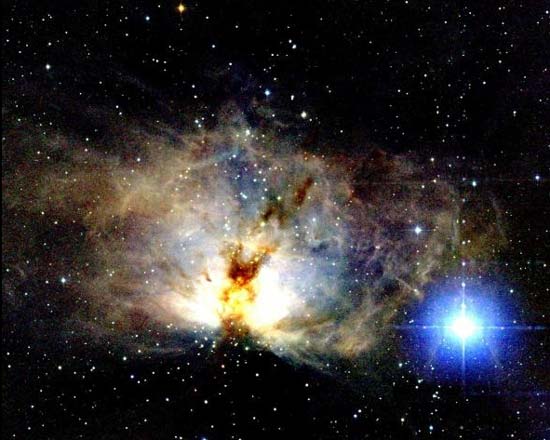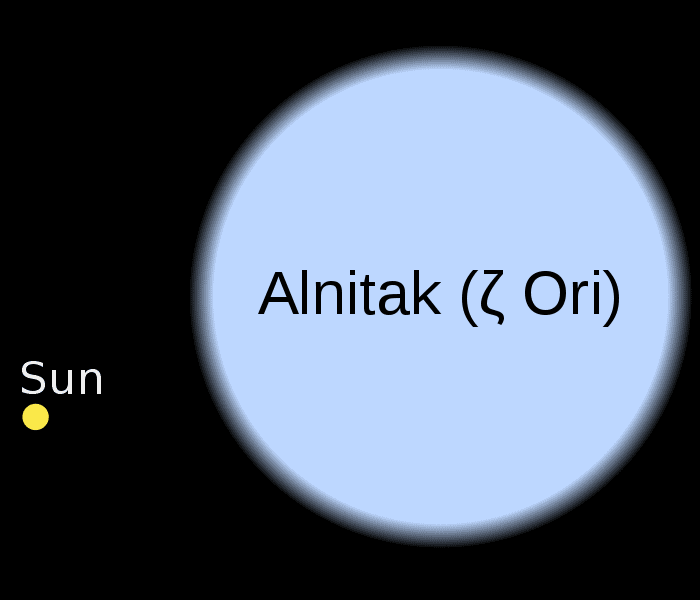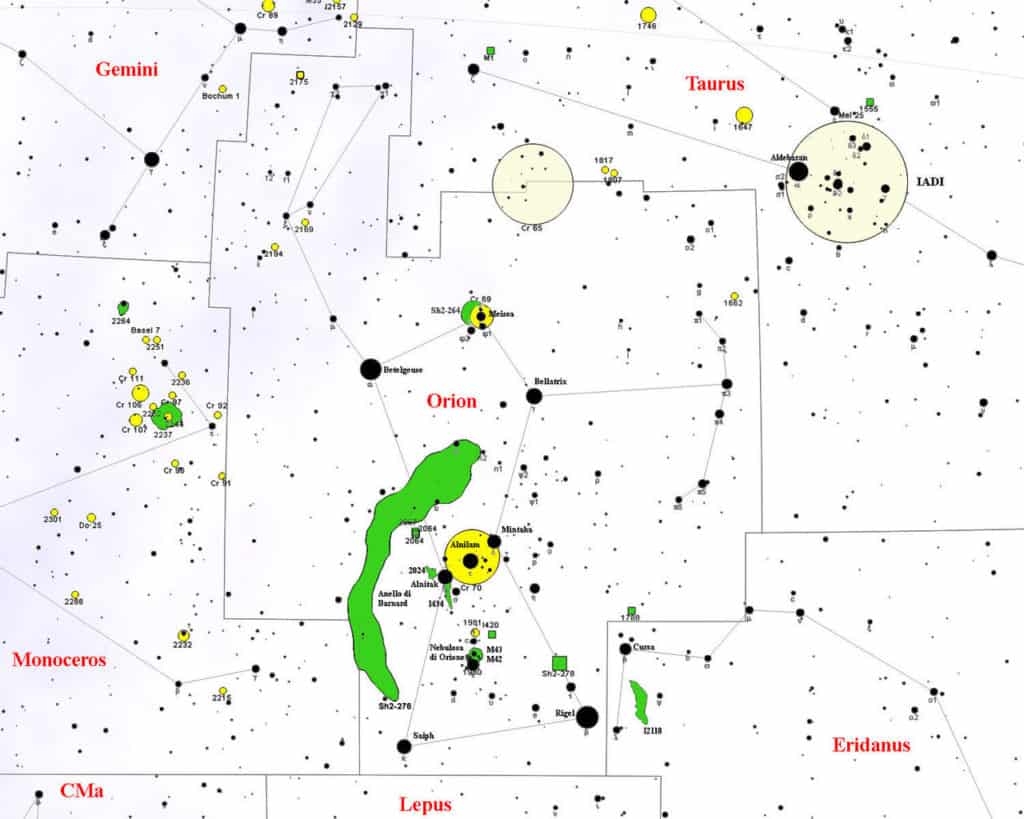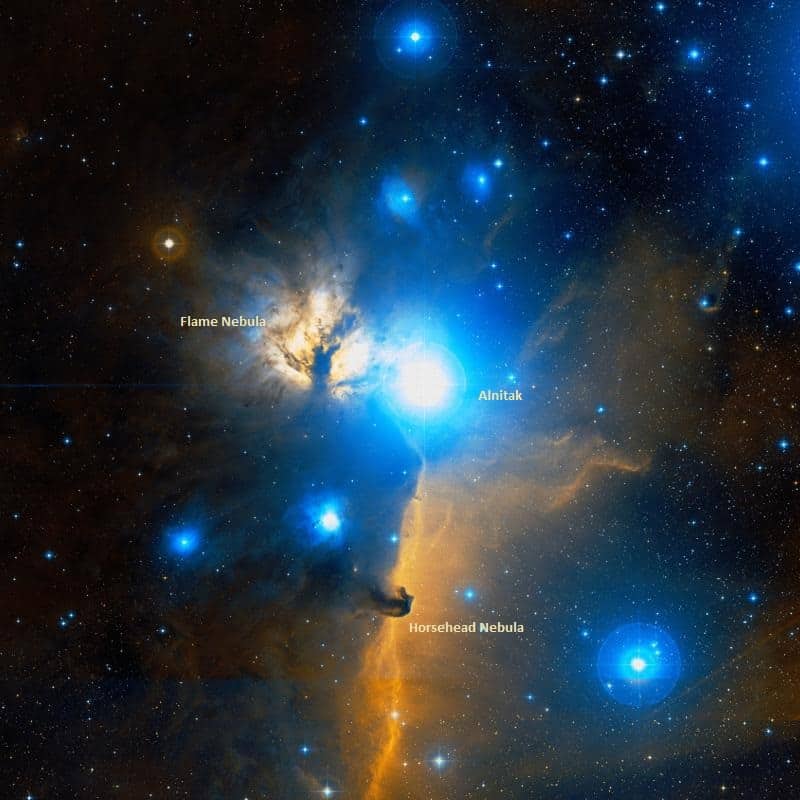Alnitak - also called Zeta Orionis and 50 Orionis, is a triple star system in the constellation of Orion. It is one of the three main stars forming Orion’s Belt. Alnitak is the 5th brightest star in its constellation and the 31st brightest star in the night sky.
Key Facts & Summary
- Alnitak is a triple star system that lies at around 1.260 light-years / 387 parsecs from the Sun.
- The star system is composed of Alnitak Aa – a blue supergiant of spectral type O9.5lab, Alnitak Ab – a blue subgiant of spectral type B1lV, and Alnitak B – a B-class blue giant star.
- The primary star, Alnitak Aa is the brightest star of class O in the night sky. It has an absolute magnitude of -6.0 and an apparent magnitude of 2.0
- The secondary star, Alnitak Ab has an absolute magnitude of -3.9 and an apparent magnitude of 4.3.
- The third star, Alnitak B has a visual magnitude of 4.01.
- All of the Zeta Orionis stars belong to the Orion OB1 association and are members of the Collinder 70 open cluster.
- Alnitak Aa has around 33 solar masses and a radius of around 20 times that of the Sun.
- Alnitak Ab has around 14 solar masses and a radius of around 7.3 times that of the Sun.
- Alnitak Aa appears to be the youngest star, at around 6.4 million years while Alnitak Ab appears to be the oldest at around 7.2 million years, and Alnitak B is in the middle at 7 million years.
- Alnitak Aa is around 250.000 times brighter than our sun while Alnitak Ab is only 32.000 times brighter than our sun.
- Alnitak Aa has a surface temperature of around 29.500 K while Alnitak Ab is at 29.000 K.
- Alnitak B appears to have the fastest rotational velocity at around 350 km / 217 mi per second.
- Alnitak is the second most massive, and the second biggest object in Orion’s Belt, after Alnilam.
Alnitak is the easternmost star that makes up the famous Orion’s Belt asterism in the night sky. This asterism has been known for thousands of years and was associated with many myths and religious beliefs.

Alnitak is a word of Arabic origin that roughly translates to “the girdle.” The traditional name was also alternatively spelled as Al Nitak or Alnitah. Orion’s Belt itself was collectively known by many names in many cultures throughout the ages. The other two stars forming Orion’s Belt are Alnilam and Mintaka.
Formation
The constellation of Orion is home to many blue stars, clusters, nebulae, and clouds of dust and gas. Star formation is pretty active in this region. All the three stars in Orion’s Belt, for example, have many other companion stars around them, thus they form multiple star systems (with the exception of Alnilam).
In the case of Alnitak, it is a triple star system, the stars here are estimated to have formed at different time periods. The primary star Alnitak Aa is actually the youngest of the system, being at around 6.4 million years old.

The secondary star, Alnitak Ab appears to be the oldest at around 7.2 million years, while Alnitak B, the third star, is in the middle, at around 7 million years. All of these stars are much younger than our Sun. Alnitak – Zeta Orionis –belongs to the Orion OB1 association in the subgroup OB1b which is part of the Orion Molecular Cloud Complex – a star-forming region with stellar ages ranging up to 12 million years old. Gas and dust from this molecular cloud, were pulled together by gravity and resulted in the many stars we now see in Orion, and thus Orion’s Belt.
Distance, Size, and Mass
The Alnitak star system is located at around 1.260 light-years / 387 parsecs from the Sun. The primary star Alnitak Aa, is the biggest of this system, having around 33 solar masses and a radius of around 20 times that of the Sun.

Alnitak Ab, the secondary star, is the second-biggest star of the system with 14 solar masses and a radius of around 7.3 times that of the Sun. Some estimates put Alnitak Ab at 23 solar masses. Alnitak B is the smallest star with an estimated mass below or also around 14 solar masses. A star’s diameter is usually two times bigger than its radius. All three stars are considerably bigger than our Sun, being at least 10 times bigger.
Other Characteristics
The primary star, Alnitak Aa, is a blue supergiant of spectral type O9.5lab. It is the brightest star of Class O in the night sky. Alnitak Aa has an absolute magnitude of -6.0 and an apparent magnitude of 2.0. Alnitak Aa is around 250.000 times brighter than our sun and it is the hottest star of its system with a surface temperature of around 29.500 K. It is five times hotter than our sun. It’s also a fast spinner, having a rotational velocity of around 110 km / 68 mi per second.

The secondary star, Alnitak Ab, is a blue subgiant of spectral type B1lV. Alnitak Ab has an absolute magnitude of -3.9 and an apparent magnitude of 4.3. Alnitak Ab is only 32.000 times brighter than our sun and has surface temperatures at around 29.000 K. It is also 5 times hotter than our sun.
The third star, Alnitak B, is a B2 III-class blue-white giant star. Alnitak B has a visual magnitude of 4.01. Alnitak B is around 1.100 times brighter than our Sun and it may be much hotter as well. Alnitak B appears to have the fastest rotational velocity in this star system, at around 350 km / 217 mi per second.
Stellar System
The binary pair is formed by Alnitak Aa and Alnitak Ab. As such, the binary pair is named Alnitak A. The two giants complete one orbit around each other once every 2.687 days.

The third companion, Alnitak B, is around 3 arc-seconds away from Alnitak A. It completes one orbit around the primary system one every 1.500 years. A fourth companion designated Alnitak C is speculated to also be part of the system, though studies indicate it is more of a visual companion and not physically related to the other stars.
Location
Alnitak is located in the constellation of Orion, the celestial hunter. It is part of the three stars forming the hunter’s belt, being the easternmost star of the three. Orion’s Belt is often used to search for the constellation itself. The other two stars forming this asterism are Mintaka and Alnilam.

The constellation of Orion is also home to two first magnitude stars, Rigel and Betelgeuse, and it also hosts the nearest star formation region to Earth. This constellation is prominent in the sky for observers in the northern hemisphere during winter, and for observers in the southern hemisphere during summer. To southern observers, the constellation appears upside down.

The Future
Because Alnitak Aa is so massive, it has already stopped fusing hydrogen in its core. Despite the star’s young age, it will eventually evolve into a red supergiant similar to Betelgeuse. After this, it will end its life in a supernova explosion, and it is possible that Alnitak Ab will share the same fate.
Did you know?
- Alnitak was long considered to be a single star until 1819 when German amateur astronomer G.K. Hunowsky reported Alnitak to in fact be a double star. This discovery was acknowledged by further evidence much later, in 1998.
- A bright emission nebula designated IC 434 has surrounded Alnitak. Due to the star's powerful ultraviolet light, a nearby nebula designated NGC 2024 is illuminated by the star.
- The best time to see Alnitak / Orion’s Belt is in mid-December and in January at around 9 PM.
- For the Chinese, Orion’s Belt was known as Weighing Beam. This asterism contained the stars in the belt and also a couple more from the constellation. Alnitak was known as The First Star of Three Stars.
- The Egyptian gods Isis and Osiris were believed to have come from Orion’s Belt and Sirius to create mankind. Orion and Sirius were associated with these divine beings.
- The three pyramids on the Giza Plateau simulate the alignment of the three belt stars. The air shafts inside the pyramids point directly to the Orion constellation.
- Two large pyramids and a temple in Mexico were discovered to point directly at Orion’s belt as well. They were built in the 2nd century B.C. One of the pyramids is exactly half as tall as the Great Pyramid of Giza.
- The people of Puerto Rico and the Philippines, the three stars in Orion’s belt represented the three biblical Magi. They were named Tres Reyes Magos.
Sources:
Image source:
- https://upload.wikimedia.org/wikipedia/commons/b/b2/Ngc2024_2mass.jpg
- https://upload.wikimedia.org/wikipedia/commons/thumb/4/47/Orion_Head_to_Toe.jpg/498px-Orion_Head_to_Toe.jpg
- https://upload.wikimedia.org/wikipedia/commons/thumb/7/79/Alnitak_sun_comparison.svg/700px-Alnitak_sun_comparison.svg.png
- https://www.star-facts.com/wp-content/uploads/2019/09/Alnitak.jpg
- https://upload.wikimedia.org/wikipedia/commons/thumb/4/4f/Orion_Belt.jpg/967px-Orion_Belt.jpg
- https://www.star-facts.com/wp-content/uploads/2019/09/Orion-constellation.jpg
- https://www.star-facts.com/wp-content/uploads/2019/09/Alnitak-Flame-Nebula-and-Horsehead-Nebula.jpg
